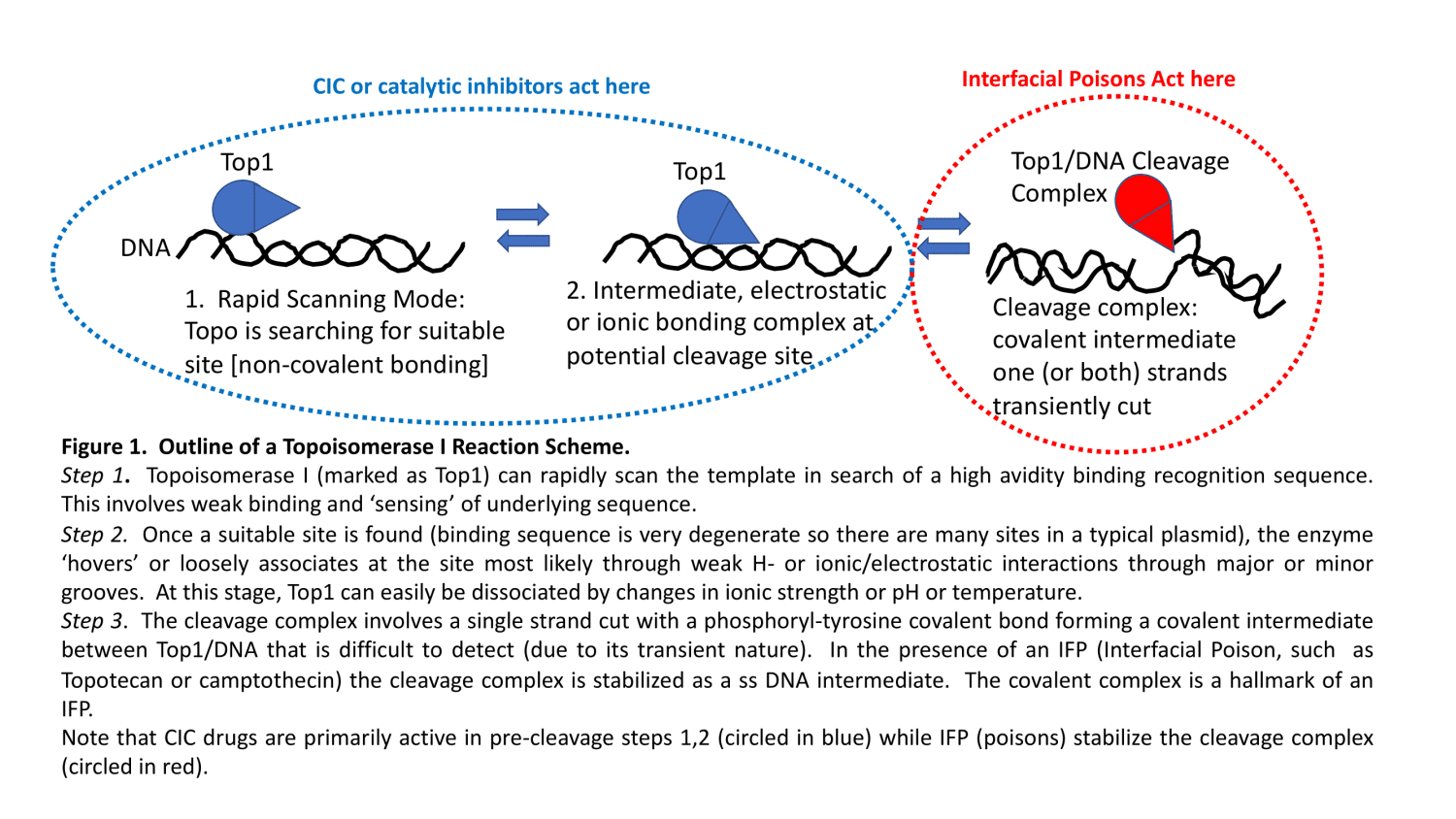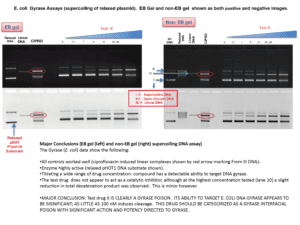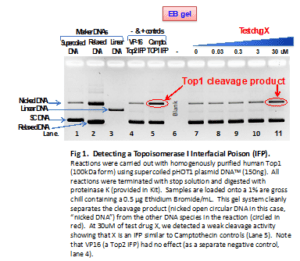Screening in Topoisomerase Inhibitors and/or Poisions.
Anticancer Screening for agents that target Human Topoisomerases: How we can advance your R&D.
TopoGEN offers powerful and tractable services to identify Topoisomerase-targeting drugs In Vitro.
Typically, Topoisomerase drugs by two distinct mechanisms:
These drugs block or restrict catalytic activity of the enzyme. Typically, CICs will act at steps 1 or 2 in the overall reaction sequence (see Fig. 1). By preventing the non-covalent (electrostatic or ionic bridge) complexes which are necessary to proceed to the cleavage complex (step 3), the reaction is effectively blocked. There are a number of Top2 CICs (ICRF-187) and many fewer Top1 CICs. Note that CICs can be highly non-specific since even elevated NaCl can even mimic a CIC. In other cases, strong DNA intercalators may interfere with the catalytic reaction sequence. Many in the field simply view a CIC as any agent that can interfere with the ability of a poison (like CPT and topo 1) to form cleavage complexes (ie, can ‘reverse or block’ the action of an IFP). This sort of dual drug testing approach can be complicated and we at TopoGEN have the view that it is better to directly test CICs in the absence of other drugs.
We offer this as a service.

Note that some drugs may display mixed modes of action, behaving as both CIC and IFP. In most cases, the inhibitory and cleavage maximal effects may occur at different concentrations of drug. Thus, they may titrate very differently.
Our Screening services: Independent validation, Expediency, value
At TopoGEN, we developed, trademarked and patented many of the technologies associated with drug effects on DNA. We are leading experts at drug testing and assessment of drug action from a mechanistic standpoint. When you engage our services, we will describe and lay out a logical/rational approach that is rich in content and strongly mechanistic. We offer independent consultants who can validate our findings. Our services offer expediency as well. We can significantly accelerate the pace of your research; produce publication quality data and you will own the intellectual property that comes with our studies. We routinely enter into confidentiality agreements on projects, so your results are protected. Our in-house testing program is flexible, fast, and efficient. You will receive publication quality data. The following are the “Top 10” reasons you should consider our screening services for your R&D needs:
All Postitive & Negative Controls
We demonstrate internally that all testing platforms are perfectly functional. As a result, there is no guessing. Your data will be clear and unambiguous. We stand behind our findings and certify the data.
All Markers will be included
To document and validate the results. Again, we certify tractable results that will be internally controlled.
Testing & Cost Flexibility
We tailor each contract to offer maximum flexibility and coordinate with you over the course of the project to ensure intellectual flow of ideas and results. We will advise you on the best course of action with all hits. You can select the level of detail for the project that best suits your needs. In some projects, there will be a need to re-examine, re-test or alter the course. How do we correct for work-load adjustments in the mid-stream? Our solution: we include on all projects, a small indirect cost that will allow us to perform additional key experiments without asking for additional funds. This is an advantage for clients and ensures that our high standards of data quality will be maintained. For example, if additional testing regimens are required, we carry out the service automatically. Importantly, there is no guessing on the budget and you will not pay additional fees.
Consulting
We are a team of topo experts. All projects include email and direct SKYPE support over the course of the project. Our scientific staff will discuss and suggest future prospects or experiments.
Reporting
For complete flexibility and to ensure cost-effective contracts, we offer two levels of reporting. At a basic level, included in all contracts, we provide well-documented data (PowerPoint, PDF or password protected cloud account). We draw conclusions, presented as bullets, on each slide and make a recommendation for further development and maturation of the project. For clients who wish to have a & ´manuscript´ style report, we offer fully referenced publication style reports. These reports are professionally prepared and are suitable for presentation to regulatory agencies. These publication style reports can be reviewed independently by third party opinion leaders in the field and the reviews appended to the final report.
Hands-on Experience
The company has been actively engaged in contract drug testing since the 1990s and we have the experience to get results that will enable ‘go/no go’ decision making on drug development.
Expedience
In most cases, the project will be completed over a period of several business days. We will clearly stipulate how long the project will take and we deliver on time.
A Selection of Enzyme Targets
We can test prokaryotic and eukaryotic systems with highly purified enzymes that are well-controlled reagents. We can provide additional documentation of purity and QC on all preparations. The following enzymes or tractable antibodies are currently in our inventory:
- Human DNA Topoisomerase I
- Human DNA Topoisomerase IIα
- E. coli DNA Gyrase
- S. aureus DNA Gyrase
- E. coli Topoisomerase IV
- S. aureus Topoisomerase IV
Advanced Testing in Living Cells
TopoGEN is a pioneer in testing agents that operate in the context of the cell. For eukaryotic systems, we can perform rigorous testing in tissue culture cells. We offer a variety of cell lines suitable for topo I, IIα and IIβ testing. For example, we can test your drug (either as CIC or IFP) in virtually any cell line of interest.
The “Dual Gel Analytical System“
TopoGEN is unique in offering this service as part of our routine testing regimen. In all projects, we design our experiments to garner new information about your compound. For example, all gels are run in duplicate. One is a non-EB gel system, used to demonstrate unambiguous catalytic activity and the other gel is an EB containing gel to parse clearly the cleavage products. Since the reactions come from the same tube, we can be sure that the results are reproducible and accurate. Importantly, the non-EB gel system also reports whether the drug is a DNA intercalator, which may suggest genotoxicity in cells.
Some Sample Data: Identifying CIC IFC, Active Agents
Detecting a Topo I IFP Active Agent: some sample data
Detecting a Topo I IFP active agent: A Dual Gel Analysis System (Fig 2).
In this analysis, we tested whether a drug might be an IFP, CIC or intercalator using our dual gel system. The controls, VP16 (a topo II IFP) and CPT (topo I IFP) clearly show that the reaction is reporting accurately since the topo II IFP drug does not induce cleavages while the topo I IFP drug (CPT control) clearly induces accumulation of nicked OC DNA (red ring). These data clearly show that test drug X is neither a CIC nor an IFP. Additionally, the test drug does not alter the distribution of topoisomers and is not a DNA intercalator. Gel A (EB Gel) is important since it reveals that the enzyme is highly active under the conditions of the experiment (as attested by the formation of nicked form II DNA in Lane 4, red circle). Note that in Gel A (EB gel) the resolution of SC and relaxed DNA species is very poor, which is normal; however, Gel B (non-EB Gel) very clearly shows that the enzyme was highly active since all supercoiled DNA was converted to relaxed set of topoisomers (marked with blue bracket, lane 6). Also, the Non-EB gel very clearly resolves all topoisomers and it is clear that the topoisomer ladder was not influenced by the test drug (lanes 6-10); therefore this drug is not a DNA intercalating agent.

Further Information
In Vitro Screening Services ⇒

